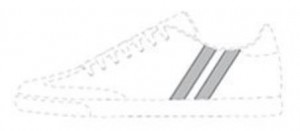ECJ upholds General Court decision in favour of Adidas
9 March 2016
Case C-396/15 P Shoe Branding Europe BVBA v Adidas AG
European Court of Justice, 17 February 2016
The European Court of Justice (ECJ) has upheld a decision of the General Court allowing Adidas to oppose the registration of a trade mark consisting of two parallel stripes placed on the side of footwear.
Shoe Branding Europe, a Belgian company, filed a Community trade mark (CTM) application in 2009 for a mark consisting of two parallel stripes applied to sports shoes. The application covered “footwear” in Class 25.
Adidas opposed the application in 2010 on the basis of several trade mark registrations, including a CTM which was registered in 2006 and consists of ‘three parallel equally spaced stripes applied to footwear, the stripes positioned on the footwear upper in the area between the laces and the sole’:
Adidas claimed that the two-stripe mark was confusingly similar to their existing three-stripe registrations and would take unfair advantage of, or be detrimental to, the repute of such marks, pursuant to Articles 8(1)(b), 8(4) and 8(5) CTMR.
The Opposition Division rejected the opposition in 2012, as did the Board of Appeal thereafter. Despite recognising that Adidas had used its three-stripe marks extensively and therefore that such marks enjoyed enhanced distinctiveness, the Board considered that Adidas’ stripe marks were so inherently non-distinctive that they could only enjoy protection against identical or highly similar reproductions.
The Board considered the positioning and number of the stripes to be highly relevant, particularly as stripes are typically merely decorative and banal elements applied to shoes and clothing. The stripes in the mark applied for sloped in a different direction to those of the Adidas marks and were positioned in the instep of the shoe rather than the area between the footwear’s laces and sole. The Board felt that these differences would not pass unnoticed by the consumer, and consequently there would be no likelihood of confusion or unfair advantage of the repute of Adidas’ earlier marks.
Adidas appealed to the General Court, which, in a judgment of May 2015, sided with Adidas and annulled the Board’s decision. The General Court believed that the Board had attributed too much importance to the inclination and number of the stripes, finding that “the differences in positioning and inclination are noticeable only if the consumer undertakes a closer inspection”.
The Court further held that the Board was wrong to disregard the ‘significant similarities’ between the signs including that they were parallel stripes, equidistant and of the same width, which contrasted with the background and were applied to the products in broadly the same position.
Shoe Branding Europe appealed to the ECJ on various grounds, including that the Court had wrongly characterised the average consumer, erred in its assessment of the likelihood of confusion and exhibited bias in favour of Adidas and its reputation in its three-stripe marks.
The decision of the ECJ dated 17 February 2016 upholds the General Court’s judgment. The ECJ agreed with the General Court in finding that the Board of Appeal had not provided a proper statement of reasons regarding the similarity of the signs at issue. On the other hand, the General Court had found that the ‘minor differences’ between the marks, such as the different lengths and angles of the stripes, were not sufficient to influence the consumer’s overall impression or negate the similarities between the marks. In the ECJ’s view, therefore, the General Court had conducted a proper assessment of the marks and hence did not err in law.
As a result, Shoe Branding Europe’s appeal was dismissed and the General Court’s decision, which allows adidas to oppose the registration of the two-stripe application, was upheld.
The decision indicates that protection for marks which might usually be incapable of registration owing to a lack of inherent distinctiveness may be notably wide once they have acquired a distinctive character through use. Without evidence of a reputation, marks such as those containing stripes might be considered only ‘banal, generic embellishments’ by the courts. Yet, once market recognition can be proven, it appears that such marks may be powerful tools for brand owners seeking to enforce their rights throughout the EU.
Martha Murray
Trade mark group
If you require further information on anything covered in this briefing, please contact Martha Murray (mmurray@withersrogers.com; +44 1179 253 030) or your usual contact at the firm.
This publication is a general summary of the law. It should not replace legal advice tailored to your specific circumstances.
© Withers & Rogers LLP, March 2016






